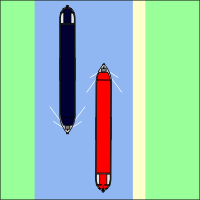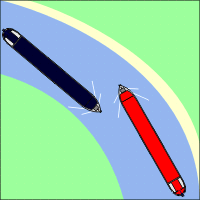Meeting Boats
Meeting other boaters should be a pleasurable experience. Always saying hello with a smile is standard procedure on the waterways.
The normal practice when meeting boats is to slow down a little to reduce the bow wave and pass port side, (left), to port side.
However, don't be afraid to pass on the other side if conditions demand such as when leaving locks or when one boat is having difficulty maintaining control. Ensure that signals are given and both parties understand.
Sometimes though it can be an unhappy meeting, especially on tight bends or narrow sections of canal. (See also "Bridges and Narrow Aqueducts").
Priority will depend on the nature of the bend or hazard, the effect of wind and water flow and the size of the boat you are meeting. In any event, a Considerate Boater will be the first to give way.
Conflict can be avoided completely by approaching all hazards at a speed that allows you to come to a controlled stop without having to use maximum power in reverse.
On approaching blind bends and bridges use your horn to give a long warning blast, (five seconds), which means "Caution". Listen for the same sound coming back.
![]()
Just like Bridges, consider the effects of wind and water flow on you and the other boat.
Generally, it is easier to give way if the flow of wind or water is against you.
It is usually easier for the person who is on the inside of the bend to give way because boats normally meet port side to port side and because of the nature of the boat steering about the mid-point.
There is an excellent method of meeting boats where both boats stay in mid channel until they get close to each other then each move out to the right to pass. Then, as you are alongside the other boat, move the tiller to the right steering the bow left toward the other boat's stern. If both boats do the same then both will make best use of the deeper part of the channel.
Look out for heavily laden working boats. They are going to need all the depth of water they can get so be prepared to move well over or even pull over to the towing path if necessary. They may also be less manoeuvrable than you.
Avoid having to do "emergency stops" by approaching all hazards at the appropriate speed. The rule when driving a motor vehicle is that you should be able to stop comfortably within the distance you can see ahead and there is no reason why this approach should not be adopted on the waterways.
In any case, having a boat disappear in a cloud of exhaust gasses when applying full reverse is not the mark of a boater in full control of his/her vessel.